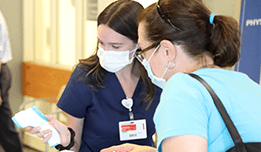Top of the pageCheck Your Symptoms
Marine Stings and Scrapes
Overview
Walking on a beach or swimming in the ocean can be fun and relaxing. But just like with any other activities, accidents can happen. This topic gives an overview of jellyfish and Portuguese man-of-war stings, seabather's eruption, and coral scrapes.
Stings
Jellyfish and Portuguese man-of-wars can be found all over the world. They cause injury and illness through the release of venom when they come in contact with skin (stinging). While the sting of a jellyfish or Portuguese man-of-war can cause severe illness and extreme pain, deaths are rare.
Jellyfish are often found in coastal waters. It's often hard to see jellyfish swimming in the water. Beached jellyfish, which may look like a clear plastic wrapper, can sting if touched.
Jellyfish stings cause intense pain and burning right away. The pain can last for several hours. Raised, red welts form along the site of the sting. The welts may last for 1 to 2 weeks, and itchy skin rashes may appear 1 to 4 weeks after the sting.
Seabather's eruption is a rash from the stings of jellyfish or sea anemone larvae. The rash can be quite itchy and annoying. But it usually goes away without medical treatment in 10 to 14 days.
Portuguese man-of-wars live in warm seas throughout the world. They float on the surface of the water with their long, stinging tentacles trailing in the water below. Detached tentacles that wash up on the beach may remain dangerous for months.
Portuguese man-of-war stings produce immediate burning pain and redness where the tentacles touched the skin. The affected area develops a red line with small white lesions. In severe cases, blisters and welts that look like a string of beads may appear. Stings that involve the eye may cause pain, swelling, excessive tears, blurred vision, or increased sensitivity to light. Severe reactions are most likely to occur in children and small adults. Severe toxic reactions to the venom can also occur.
Stingrays have sharp spines in their tails that can cause cuts or puncture wounds. The spines also have venom. Stingrays don't bite, but they can suck with their mouths and leave a bruise.
Coral scrapes
Coral scrapes and cuts are common injuries that may occur when you walk on a beach or swim, snorkel, or dive in warm water. You may get a skin infection if small pieces of coral, other debris, and bacteria get inside the wound. Scrapes and cuts from sharp-edged coral may take weeks or even months to heal.
Check Your Symptoms
The medical assessment of symptoms is based on the body parts you have.
- If you are transgender or nonbinary, choose the sex that matches the body parts (such as ovaries, testes, prostate, breasts, penis, or vagina) you now have in the area where you are having symptoms.
- If your symptoms aren’t related to those organs, you can choose the gender you identify with.
- If you have some organs of both sexes, you may need to go through this triage tool twice (once as "male" and once as "female"). This will make sure that the tool asks the right questions for you.
Many things can affect how your body responds to a symptom and what kind of care you may need. These include:
- Your age. Babies and older adults tend to get sicker quicker.
- Your overall health. If you have a condition such as diabetes, HIV, cancer, or heart disease, you may need to pay closer attention to certain symptoms and seek care sooner.
- Medicines you take. Certain medicines, such as blood thinners (anticoagulants), medicines that suppress the immune system like steroids or chemotherapy, herbal remedies, or supplements can cause symptoms or make them worse.
- Recent health events, such as surgery or injury. These kinds of events can cause symptoms afterwards or make them more serious.
- Your health habits and lifestyle, such as eating and exercise habits, smoking, alcohol or drug use, sexual history, and travel.
Try Home Treatment
You have answered all the questions. Based on your answers, you may be able to take care of this problem at home.
- Try home treatment to relieve the symptoms.
- Call your doctor if symptoms get worse or you have any concerns (for example, if symptoms are not getting better as you would expect). You may need care sooner.
Pain in adults and older children
- Severe pain (8 to 10): The pain is so bad that you can't stand it for more than a few hours, can't sleep, and can't do anything else except focus on the pain.
- Moderate pain (5 to 7): The pain is bad enough to disrupt your normal activities and your sleep, but you can tolerate it for hours or days. Moderate can also mean pain that comes and goes even if it's severe when it's there.
- Mild pain (1 to 4): You notice the pain, but it is not bad enough to disrupt your sleep or activities.
Pain in children under 3 years
It can be hard to tell how much pain a baby or toddler is in.
- Severe pain (8 to 10): The pain is so bad that the baby cannot sleep, cannot get comfortable, and cries constantly no matter what you do. The baby may kick, make fists, or grimace.
- Moderate pain (5 to 7): The baby is very fussy, clings to you a lot, and may have trouble sleeping but responds when you try to comfort him or her.
- Mild pain (1 to 4): The baby is a little fussy and clings to you a little but responds when you try to comfort him or her.
Symptoms of infection may include:
- Increased pain, swelling, warmth, or redness in or around the area.
- Red streaks leading from the area.
- Pus draining from the area.
- A fever.
Symptoms of difficulty breathing can range from mild to severe. For example:
- You may feel a little out of breath but still be able to talk (mild difficulty breathing), or you may be so out of breath that you cannot talk at all (severe difficulty breathing).
- It may be getting hard to breathe with activity (mild difficulty breathing), or you may have to work very hard to breathe even when you're at rest (severe difficulty breathing).
Symptoms of a severe allergic reaction (anaphylaxis) may include:
- The sudden appearance of raised, red areas (hives) all over the body.
- Rapid swelling of the throat, mouth, or tongue.
- Trouble breathing.
- Passing out (losing consciousness). Or you may feel very lightheaded or suddenly feel weak, confused, or restless.
- Severe belly pain, nausea, vomiting, or diarrhea.
A severe reaction can be life-threatening. If you have had a bad allergic reaction to a substance before and are exposed to it again, treat any symptoms as an emergency. Even if the symptoms are mild at first, they may quickly become very severe.
Certain health conditions and medicines weaken the immune system's ability to fight off infection and illness. Some examples in adults are:
- Diseases such as diabetes, cancer, heart disease, and HIV/AIDS.
- Long-term alcohol and drug problems.
- Steroid medicines, which may be used to treat a variety of conditions.
- Chemotherapy and radiation therapy for cancer.
- Other medicines used to treat autoimmune disease.
- Medicines taken after organ transplant.
- Not having a spleen.
Usually found in dirt and soil, tetanus bacteria typically enter the body through a wound. Wounds may include a bite, a cut, a puncture, a burn, a scrape, insect bites, or any injury that may cause broken skin. Tetanus can also happen with other infections, like dental infections. It can happen during a surgery or pregnancy and delivery.
A wound can be so small, you may not notice you have one. Or a skin blister could break and become an open wound. If there is any delay in finding or cleaning a wound, there is an increased risk for skin infection and a chance for tetanus to get in the wound. A tetanus infection can start 3 to 21 days after the bacteria enter the wound. Be especially careful about wounds on your fingers and toes.
Many people may not know when they got their last tetanus shot. So it's a good idea to call your doctor to see if you need one.
Make sure to stay up to date on your tetanus shots. A tetanus shot is recommended:
- For a dirty wound that has things like dirt, saliva, or feces in it, if you haven't had a tetanus shot in the past 5 years.
- For a clean wound, if you haven't had a tetanus shot in the past 10 years.
Shock is a life-threatening condition that may quickly occur after a sudden illness or injury.
Adults and older children often have several symptoms of shock. These include:
- Passing out (losing consciousness).
- Feeling very dizzy or lightheaded, like you may pass out.
- Feeling very weak or having trouble standing.
- Not feeling alert or able to think clearly. You may be confused, restless, fearful, or unable to respond to questions.
Shock is a life-threatening condition that may occur quickly after a sudden illness or injury.
Babies and young children often have several symptoms of shock. These include:
- Passing out (losing consciousness).
- Being very sleepy or hard to wake up.
- Not responding when being touched or talked to.
- Breathing much faster than usual.
- Acting confused. The child may not know where he or she is.
Call 911 Now
Based on your answers, you need emergency care.
Call 911 or other emergency services now.
Sometimes people don't want to call 911. They may think that their symptoms aren't serious or that they can just get someone else to drive them. Or they might be concerned about the cost. But based on your answers, the safest and quickest way for you to get the care you need is to call 911 for medical transport to the hospital.
Yellow Disposition (Generic)
Seek Care Today
Based on your answers, you may need care soon. The problem probably will not get better without medical care.
- Call your doctor or telehealth provider today to discuss the symptoms and arrange for care.
- If you cannot reach your doctor or telehealth provider or you don't have one, seek care today.
- If it is evening, watch the symptoms and seek care in the morning.
- If the symptoms get worse, seek care sooner.
What are your options for medical care?
Today your options for where to get your medical care are greater than ever before. You may not even have to leave your home to get the care you want and need. You can choose based on what your health problem is and what works best for you.
- Telehealth is a video call with a health care provider. It can be a convenient way to get medical advice or treatment. Some insurers provide access to telehealth that may be available 24 hours a day. Telehealth for less serious problems may cost less and be faster than in-person clinic visits.
- Urgent care and retail clinics are options if you don't have a doctor, you can't or don't want to wait to see your own doctor, or a telehealth visit can’t treat the problem.
- Virtual care from your primary provider or a telehealth service can be delivered through your smartphone, computer, or tablet.
Seek Care Now
Based on your answers, you may need care right away. The problem is likely to get worse without medical care.
- Call your doctor now to discuss the symptoms and arrange for care.
- If you cannot reach your doctor or you don't have one, seek care in the next hour.
- You do not need to call an ambulance unless:
- You cannot travel safely either by driving yourself or by having someone else drive you.
- You are in an area where heavy traffic or other problems may slow you down.
Black Disposition (Generic)
Make an Appointment
Based on your answers, the problem may not improve without medical care.
- Make an appointment to see your doctor in the next 1 to 2 weeks, or contact your telehealth provider.
- If appropriate, try home treatment while you are waiting for the appointment.
- If symptoms get worse or you have any concerns, call your doctor or telehealth provider. You may need care sooner.
What are your options for medical care?
Today your options for where to get your medical care are greater than ever before. You may not even have to leave your home to get the care you want and need. You can choose based on what your health problem is and what works best for you.
- Telehealth is a video call with a health care provider. It can be a convenient way to get medical advice or treatment. Some insurers provide access to telehealth that may be available 24 hours a day. Telehealth for less serious problems may cost less and be faster than in-person clinic visits.
- Urgent care and retail clinics are options if you don't have a doctor, you can't or don't want to wait to see your own doctor, or a telehealth visit can’t treat the problem.
- Virtual care from your primary provider or a telehealth service can be delivered through your smartphone, computer, or tablet.
Self-Care
Caring for a jellyfish or Portuguese man-of-war sting
Any stings to the eyes need emergency treatment.
Try these tips for caring for a sting from a jellyfish or Portuguese man-of-war.
- Don't rub.
- Do not rub the tentacles with your hands, a towel, sand, or clothing.
- Remove the tentacles carefully.
- Pick off tentacles with a stick or your hand protected by a towel or glove. Be very careful not to rub or press the tentacles.
- Try a nonprescription medicine to relieve itching, redness, and swelling. Be safe with medicines. Read and follow all instructions on the label.
- An antihistamine that you take by mouth may help relieve itching, redness, and swelling.
- Hydrocortisone 1% cream applied to the skin may help relieve itching and redness. You may need to check with your doctor first if you need to use the cream for a child younger than age 2 or you need to use it in the genital area.
If a sting leaves open sores, clean them 2 times a day. Apply a thin layer of petroleum jelly (such as Vaseline), and cover with a light bandage.
Caring for coral scrapes and cuts
Try these tips for caring for minor coral scrapes or cuts.
- Wash the wound.
- Wash your hands well with soap and water, if available.
- Put on medical gloves before cleaning the wound, if available.
- Remove large pieces of dirt or other debris from the wound with cleaned tweezers. Do not push the tweezers deeply into the wound.
- Wash the wound with soap under running tap water (the more the better) to remove all the dirt, debris, and bacteria from the wound.
- Scrub gently with a washcloth. (Moderate scrubbing may be needed if the wound is very dirty.) Hard scrubbing may actually cause more damage to the tissue and increase the chance of infection. Scrubbing the wound will probably hurt and may increase bleeding, but it is necessary to clean the wound thoroughly.
- After washing, rinse the wound with a large amount of water.
- After rinsing with water, rinse the wound again with a solution of one-half hydrogen peroxide and one-half water.
- After rinsing with a solution of one-half hydrogen peroxide and one-half water, rinse again with fresh water.
- Stop bleeding with direct pressure to the wound.
- Apply a nonstick bandage.
- Cover the wound with a thin layer of petroleum jelly, such as Vaseline, and a nonstick bandage.
- Apply more petroleum jelly and replace the bandage as needed.
- Apply a clean bandage when it gets wet or soiled to further help prevent infection.
- If a bandage is stuck to a scab, soak it in warm water to soften the scab and make the bandage easier to remove.
- Watch for symptoms of a skin infection.
Be patient. Coral scrapes and cuts may take weeks and sometimes even months to heal completely.
Caring for seabather's eruption
Here are some self-care tips for seabather's eruption.
- Prevent more stings.
- Don't rub your skin. If larvae are on your skin, rubbing will cause them to sting.
- Remove your swimsuit as soon as you can. Larvae can get trapped in the fabric of your suit. So it's important to remove a contaminated suit to prevent more stings. The swimsuit needs to be machine washed or rinsed in rubbing alcohol or vinegar and then washed with soap and water to get rid of any larvae.
- Rinse with vinegar or rubbing alcohol.
- If available, use household vinegar (5% acetic acid solution) or rubbing alcohol (40%–70% isopropyl alcohol) to rinse your skin.
- Shower with fresh water.
- Apply soap, and vigorously scrub your skin.
- Don't shower with a contaminated suit on. If larvae are trapped in the fabric of a suit, a freshwater shower will cause the larvae to sting.
Try a nonprescription medicine to relieve itching, redness, and swelling. Be safe with medicines. Read and follow all instructions on the label.
An antihistamine that you take by mouth may help relieve itching, redness, and swelling.
Hydrocortisone 1% cream applied to the skin may help relieve itching and redness. You may need to check with your doctor first if you need to use the cream for a child younger than age 2 or you need to use it in the genital area.
Wash the rash with clean water daily.
When to call for help during self-care
Call 911 if any of the following occur during self-care at home:
- New or worse trouble breathing, wheezing, or tightness in the chest.
- New or worse swelling of the throat, tongue, lips, or mouth.
Call a doctor if any of the following occur during self-care at home:
- New or worse rash.
- New or worse signs of infection. This may include redness, warmth, swelling, pus, or a fever.
Learn more
Credits
Current as of: July 31, 2024
Author: Ignite Healthwise, LLC Staff
Clinical Review Board
All Healthwise education is reviewed by a team that includes physicians, nurses, advanced practitioners, registered dieticians, and other healthcare professionals.




